Transformative Technology Allows Seawater to Capture and Store Carbon
Carbon removal company, Equatic’s white Paper outlines rigorous MRV framework to validate its process.
#automation
Carbon removal company, Equatic, has developed a revolutionary process that relies on seawater electrolysis to capture and store carbon dioxide (CO2), while simultaneously producing clean hydrogen. A new white paper written after consultation with EcoEngineers (Eco), a clean energy consulting, auditing, and advisory firm, outlines Equatic’s approach to quantifying and verifying Equatic’s carbon removal process.
“White Paper: Equatic's Measurement, Reporting, and Verification Methodology,” outlines the Equatic process, which is intentionally designed and engineered to measure carbon dioxide removal (CDR) within a closed system. The system uses online and on-stream sensors to measure the chemical composition of the seawater inflow, the processed water flows, the retained solids, and the air, ensuring Equatic has a precise and accurate measurement of CO2 drawdown.
Continuous, unambiguous data about operational performance can be obtained directly from in-plant measurements of CDR rate and extent. This data-driven approach ensures that the carbon removal process is meticulously monitored and recorded.
Concurrent with the preparation of this white paper, Eco is preparing the Equatic MRV methodology, drafted in alignment with ISO 14064-2:2019, that provides rules for eligibility, means of quantification, monitoring instructions, reporting requirements and verification parameters for projects generating carbon removal credits using the Equatic seawater electrolysis process.
“Equatic's innovative approach offers hope in the battle against the pressing issue of global warming,” Roxby Hartley, Ph.D., climate risk director for Eco. “As governments, industries, and individuals seek sustainable solutions, the Equatic process shows strong promise.”

This illustration outlines Equatic's electrolytic carbon dioxide removal (CDR) concept. Photo Credit: Equatic
The Equatic Process in Carbon Removal
At the heart of the white paper lies the Equatic process, a transformative electrolytic approach for CDR. This process leverages the natural equilibrium between the ocean and the atmosphere to create an efficient means of trapping and storing CO2 within aqueous bicarbonates and solid carbonates. By utilizing the abundant alkaline cations present in seawater, such as magnesium and calcium ions, Equatic has harnessed a continuous process to immobilize CO2 as stable, long-lasting compounds.
“Equatic is the first ocean-based CDR technology to deploy a closed system MRV,” said Dr Erika La Plante, Head of MRV & Environmental Impact Assessment at Equatic. “The carbon removal market is growing, and the highest-value credits are measurable and permanent. By working with Eco to develop a methodology, we are establishing principles for carbon accounting and ISO-standard reporting and verification to provide quality assurance for CDR credits.”
Ensuring Permanent Carbon Storage
One of the key features of the Equatic process is its focus on permanence. The captured CO2 is stored as solid carbonates and aqueous bicarbonate ions, both of which offer long-term storage solutions. Equatic’s calculations reveal that solid carbonates can immobilize carbon dioxide for billions of years, while aqueous bicarbonates can provide storage for more than 10,000 years. This makes Equatic’s carbon removal approach a promising contender for tackling the issue of atmospheric carbon accumulation.
“The Equatic white paper showcases a preliminary pathway to leverage voluntary carbon markets,” said Hartley. “The credibility of carbon credits depends on implementing a comprehensive approach to measuring, reporting, and verification. We believe Equatic is on the right path to do this.”
RELATED CONTENT
-
General Considerations for Control and Choke Valves Used in Offshore Oil and Gas Production
The application of control and choke valves used in offshore oil and gas production is a very broad field and in this article, some of the main considerations for valve selection will be addressed.
-
PFAS Chemicals and PTFE: Should the Valve Industry Be Concerned?
Legislation moving through Congress could affect the future use of thousands of PFAS chemicals (per- and polyfluoroalkyl). The house passed H.R. 2467 in July of 2021 and, though the bill is general in nature, it assigns the responsibility to the Environmental Protection Agency (EPA) for determining which PFAS chemicals will be controlled or banned altogether.
-
The Pulp and Paper Industry
The pulp & paper industry has seen tough times, but the business will still be around for many decades; the product is too much in demand.







 Unloading large gate valve.jpg;maxWidth=214)

